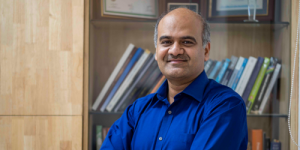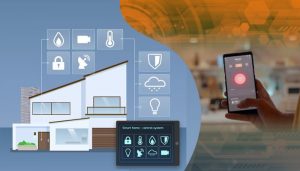India is on the cusp of a big technology leap. Smart phones will soon control fully automated homes in smart cities. And that is just the tip of the iceberg. Read on to know how IIITH is contributing to these smart homes.
The technology of tomorrow will have your fingers tap-dancing on your mobile phone or tablet, to remotely control equipment, security, and entertainment systems in your house. Fully automated-homes in connected-cities with smart power grids are set to revolutionize our lifestyle and the way we engage with devices.
If you watched the Jetsons’ in the 1960s, you would have assumed that we would have Rosie the Robot, spinning around our homes in the new millennium. Instead, we have virtual assistants like Alexa and Siri, Google Assistant for remote babysitting and for controlling air conditioning and lights.
Anything you can visualize, is now being automated; from turning your lights on, first thing in the morning, to drawing the curtains, working your washing machine and the coffeemaker that brews your morning cup of cheer. Researchers like Prof. Vishal Garg, Head, Center for IT in Building Science at IIITH are now scaling it up to the level of the whole house and front-lining the discussion on residential energy efficiency and demand response.

Smart energy home cuts your power bill
Research has revealed that about 25-30% energy saving is possible in a Smart Energy Home. But how do you quantify the benefits? A smart energy home achieves operational energy efficiency by monitoring consumption, providing feedback on when to operate your energy-consuming devices and being demand response ready. Demand response (DR) is broadly defined as a measure for reducing energy load in response to supply constraints, generally during periods of peak demand.
Energy saving or cost saving can be achieved in two ways. For example, tech pundits will tell you that an efficient set point for an air-conditioner is at 26 degrees Celsius. For running shiftable loads such as your washing machine or charging your electric vehicle, a differential tariff structure based on time of the day will result in cost saving, by shifting some of the loads from a higher to lower tariff time slot.
Why now?
Like most sectors, the Power transmission grid is also moving towards digitization, thus making it essential for its end nodes i.e., the homes to be smart. Power generation is increasingly getting decarbonized, using a combination of renewable energy sources with the traditional ones. The grid will see a lot of volatility because of the unpredictability of renewables and widespread usage of EVs (electric vehicles) in the future.
With the ever-increasing demand, smart technology will make the home as a Buffer (supplying to the grid when necessary and reducing consumption, at times of lower generation). Enter the Prosumer, consumers who will produce energy and supply to the grid. With Vehicle to grid (V2G), the homeowner will be able to tweak energy consumption and reduce load by using vehicle batteries to run home -appliances or even supply energy to the grid.
Drivers to Smart energy homes
The penetration of Internet of Things (IoT) as a technology and the seamless implementation of artificial intelligence (AI) are principal drivers for smart energy homes. Advances in IoT technology has made consumer grade technology and Do-It-Yourself kits accessible. An internet-connected home is now affordable; with efficient operation shifting to analytics, artificial intelligence to guide the consumer and chat bots to fix glitches.

Research @ IIITH
IIITH is working on the Department of Science & Technology-funded RESIDE (Residential building energy demand reduction in India), an Indo-UK collaboration that will attempt to understand the electricity consumption pattern in 2,000 representative homes, spread across several cities in five climatic zones in the country. Low-cost loggers will record overall electricity use and indoor temperature. Concurrently, a field survey of household and property characteristics will be conducted.
A smart home energy management system (SHEMS) has been designed as a part of the project. The SHEMS will allow the homeowner to adjust his device-usage to optimize energy-efficiency with continuous feedback. This system will be deployed in 200 homes in Hyderabad and trialled to assess the impact of energy feedback on users’ energy consumption behaviour. Parameters like normative feedback (comparison with neighbours), energy saving tips and time-varying tariff structures will assist the smart homeowner in making informed decisions on appliance usage.
The SHEMS consist of energy meters that will monitor the overall dwelling energy consumption. Smart sockets will monitor appliance-level energy consumption along with low-cost sensors like window open/close sensors, a temperature humidity sensor, and an IR emitter to remotely control connected-devices. A unified app acts as a platform to display the data captured from monitoring devices and sensors, and for control and scheduling options. A Smart home lab on the IIITH campus mimics a single bedroom furnished apartment with essential consumer appliances to test the sensors and connected devices.
“The field studies over a 12-month period will provide a detailed understanding of the usage pattern to generate an online repository of data of residential energy and thermal comfort”, observed Prof. Garg.
The holistic research in RESIDE brings together an inter-disciplinary team of architects, engineers, digital scientists, urban planners, and behavioural researchers to assess various aspects of the residential energy issue, including performance of the building envelope. Project partners (Oxford Brookes University, UWE Bristol and MNIT Jaipur) along with industry, real-estate partners and technical bodies will generate a multi-domain dataset to help researchers in developing typical residential archetypes for India.
A joint research study with the Cognitive sciences center at IIITH will design a user-friendly feedback interface, to understand the social and cultural drivers for energy consumption and the nudges that can effectively change behaviour. “Some of the talking points in sustainable design dovetail beautifully with a SHEMS, like water, energy and IAQ”, said Prof. Vishal Garg.
Smart home market and challenges
In recent years, the discerning consumer has the benefit of better access to different manufacturers and service providers and an opportunity to tailor a curated solution, suited to their specific requirements. “In market research, we found that there are a lot of smart devices available but what is missing, is something to connect them all together”, observed Prof. Garg.
The flipside of having multiple manufacturers is the challenge of interoperability. For instance, if my smart bulb and air-conditioner have different manufacturers, I will need multiple apps in my smart phone to operate them. Cyber risk, the security of the consumer’s data and privacy are other important concerns.
Business models and the way forward
“The drivers to smart homes are efficient technology, an astute understanding of humans and good building codes. But it will only work if we have effective business models”, pointed out Prof Garg. Today, the business model is on hiring of a bundle of smart home devices and services that are centrally managed by a service provider and can be customized by individuals. A finding indicates that entertainment devices like smart speakers, Set-top boxes and Wi-Fi routers are popular entry points for smart energy homes. Looking ahead, we think that smart home system will be a subscription-based package that will include maintenance, installing upgrades and ensuring replacements, just like a cable TV business model.. These trends will play a big role in revolutionizing the Smart Home sector.
Prof. Vishal Garg is working with Deloitte under GIZ supported project – The Smart Home Program-Technology Assessment Study and Pilot Design, to understand the potential of the smart home market and help develop the program. He says, “To drive economies of scale, we will need to bring stakeholders together and roll out a national level policy to certify smart homes, give incentives and address issues of interoperability, privacy and standardization”.
The country’s residential energy domain is a goldmine waiting to be explored. Recent research by the International Energy Agency (IEA) forecasts that by 2030, India will overtake the European Union as the world’s third-largest energy consumer.
“The work that we do is highly applied, and not fundamental research”, said Prof. Vishal Garg, who is hopeful that IGBC would include credits for smart homes in future green rating protocols. “We ensure that whatever we are doing, we are connected very well with the industry. Two things which will disrupt the way we see the grid right now are renewables and electric vehicles”, prophesized Prof. Garg. “An electric car can be a bigger load than the whole house and once it gets popular, SHEMS will play a critical role in deciding where to draw energy from”.


